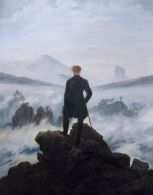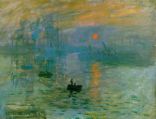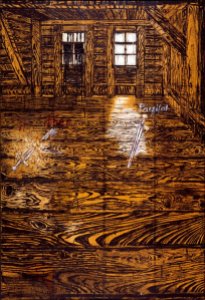Romanticism
Romanticism was anti-industry and anti-materialistic movement of the end of the 18th century. Emotions were key to the Romantics. They were against all former styles of academic art. They were very fond of the word ‘sublime’ which makes me think of Turner. They wanted to paint the experience of confronting the sublimity of untamed nature and its picturesque qualities, both of which were new aesthetic categories.
Key artists include Casper David Friedrich who painted the chosen ‘key work’.
This piece uses the technique of the Rückenfigur—a person seen from behind, contemplating the view. The viewer is asked to put himself in the position of the Rückenfigur, by which means he experiences the sublime potential of nature, understanding that the scene is as perceived and idealised by a human.
Impressionism
Impressionism, a 19th-century art movement, is another ism which rejected the academic tradition of the past (perhaps a prerequisite for any credible ism). The Impresssionists wanted to capture the moment, capture the light and paint the human perception of the light at that particular moment in time. Critics said that the paintings of the Impressionists looked unfinished. The Impressionists stated that they actually like the sensation of painting bold brush strokes. It was a much freer art than the art of previous generations. The technology of painting had recently changed, paint came in tubes, pots, and artists could paint outdoors and ‘capture’ the moment as they aimed to.
Key artists include Monet, Pierre-Auguste Renoir, Alfred Sisley and Frederic Brazille. There are so many key works so I’ll just choose a random Monet.
Neo-Expressionism
This was a movement which rose up in the 1970s. The Neo-Expressionists painted strong images to get an emotional reaction. Abstract art was in the ascendent, so the Neo-Expressionists were a group of artists aiming to use figurative art to reflect violent feelings. Many of the Neo-Expressionists were German or Austrians, reacting to their pasts.
The key work chosen was this work by Anselm Kiefer.
Secessionism
This movement was about seceding from the establishment, hence the name. The Secessionists wanted to move away from what existed previously (as all ‘ists’ seem to want to do). They were rebelling against the old academic tradition. This movement started at the end of the 19th century and lasted until the early 20th century. The style was quite decorative and flat, and suggestive rather than obvious, but using a rich pallet of colours. The Secessionists wanted the observer to need to work out the context of the work. They used symbolism and ambiguity in their paintings.
The key work and main key artist chosen was Gustav Klimt and his famous ‘Kiss’.
References:
Tutorial Notes




